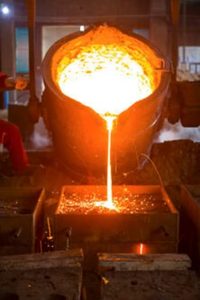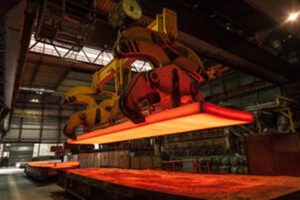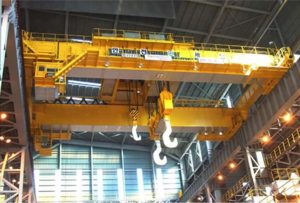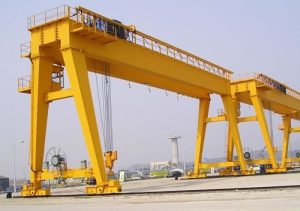Magnet Cranes
Also referred to as electromagnetic cranes, these cranes are used to handle and move metals like steel and iron. Magnet cranes can be found mostly in recycling plants and scrap yards. They operate using a magnetic field that is formed by an electric current passing through windings around the magnet. The magnet is turned on and off when needed by the electric current. The electrical current travels through an electromagnet that consists of an iron middle with a wire enclosed. These cranes have a simple job; moving metals from one area to another. The magnet picks up metals, moves them to where they are supposed to go, and the magnet is cut off, releasing the metals.
Charge Cranes (Teeming Crane)
Charge cranes are found in steel-smelting furnace units to load scrap or ore into the furnace. Charge cranes can be floor-mounted (underslung) or raised overhead. Floor-mounted charging cranes are installed in shops with large furnaces that have a capacity of 150 tons or more. Machine assemblies are installed on a bridge and they move along rails arranged on the platform of the furnace bay. The load volume for these cranes can reach 15 tons. With a simple design, they are reliable in output with high production. One machine can handle four furnaces. Floor-mounted cranes without rails can move multi-directionally and are designed to service lower capacitance furnaces. They can move easily, even on small platforms. Overhead charging cranes are designed for medium capacity furnaces (20-150 tons). The overhead crane consists of a bridge crane with a central carriage and secondary carriage. Its role is repair work and slag removal. One of the advantages of the overhead crane is absence of rails which allows for easier servicing of furnaces.
GANTRY CRANE
Gantry cranes are used outdoors and move on legs to support bridge, trolley and hoist instead of operating on suspended rails. It’s a perfect crane when you need something lightweight for applications that involve transferability. They are also used when an overhead system is not required or full beams can’t be installed.Gantry cranes come in many designs:
- Adjustable – Welding and fabrication factories use them for lifting parts and equipment
- Portable – Used for maintenance
- Track-mounted – Used for applications that require lifting and moving heavy loads
Gantry cranes are budget friendly when expensive equipment is out of reach or there’s constant change within your plant and portability is a must.
LE CRANES
Ladle cranes are one of the main pieces of equipment used in steel-making process. The primary function of this crane is to pour liquid iron to the convertor in the feeding bay and carry liquid steel to refining furnace. There are three structures for a ladle crane:
- Double-Girder/Double-Rail
- Four-Girder/Four-Rail
- Four-Girder/Six-Rail
The first two are designed for medium tonnage ladle cranes while the four-girder/six-rail are designed to handle heavy-tonnage.




